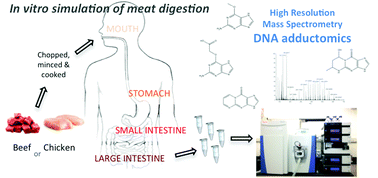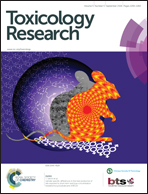In vitro DNA adduct profiling to mechanistically link red meat consumption to colon cancer promotion†
Abstract
Colorectal cancer (CRC) is the third most common cancer type in the world. Epidemiological research has demonstrated that both red and processed meat consumption significantly contribute to CRC risk. In this study, red meat toxicity was investigated by means of simulated gastrointestinal conditions, malondialdehyde (MDA) analysis and UHPLC-(HR)MS(/MS) based DNA adductomics. Since dairy products with high calcium content are associated with a decreased CRC-risk, the possible CRC-protective effects of calcium were assessed as well. The obtained results confirmed the earlier reported finding that heme-rich meat stimulates lipid peroxidation and O6-carboxymethylguanine (O6-CMG) DNA adduct formation during digestion. Calcium carbonate (CaCO3) supplementation resulted in both toxic and anti-toxic effects; i.e. stimulation of O6-CMG production, but reduction of MDA formation. DNA adductome mapping of meat digests revealed a significant interindividual variability. The observed DNA adduct profile also differed according to the digested meat type, uncovering different putative DNA adducts that seem to be associated with digestion of beef or chicken with or without supplemented CaCO3. Formamidopyrimidine-adenine was found to be discriminative for meat digests without added CaCO3, carboxyethylcytosine was significantly higher in beef digests and methoxymethylcytosine (or its hydroxyethylcytosine isomer) was found to be lower in meat digests supplemented with CaCO3. These results demonstrate that DNA adduct formation may be involved in the pathway that links red meat digestion to CRC promotion. In addition, the possible CRC-protective attributes of calcium through anti-oxidant actions could be documented.


 Please wait while we load your content...
Please wait while we load your content...